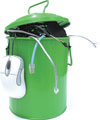

Wireless sensing is the most important new technology in process measurement to appear in decades. For this reason alone it has attracted the sustained attention of ARC Advisory Group and other industry analyst organisations. While growth of wireless measurements in industrial applications has proven to be slower than most forecasts, wireless continues to grow much faster than the overall automation market.
Looking at the changes in wireless sensor networking (WSN) during the past year, ARC is most impressed by the greater maturity of the industry along with significant new technical achievements. We believe that both will spur market growth because they enable a much larger set of customers to be well served. Recent events help illustrate how these developments have changed (and will continue to change) the wireless sensing market.
Commercial maturity
Greater WSN industry maturity has come through a steady series of acquisitions. At present, almost all the pioneering sensor networking ventures have been acquired by much larger companies. Most of the acquirers are well-established semiconductor suppliers. Virtually all the fabless WSN firms have now been snapped up. Dust Networks has become one of the most recent, acquired in late 2011 by specialist Linear Technology Corporation.
Fortune 1000 companies must carefully manage the technologies they employ if they are to meet their customer expectations. A technology that is sourced from a group of venture-stage fabless semiconductor firms represents a major supply chain risk to global firms whose customers expect product support for many years going forward. Today, the list of WSN suppliers no longer represents an exceptional risk to the supply chains of global giants like Emerson, GE, Honeywell, and Siemens.
Technical growth
WSN has also grown technically during the past year. The most important development is the completion of the ‘e’ revision to the IEEE 802.15.4 standard. Though the 15.4 standard has been published for years, most commercial WSN applications have used non-standard medium access (MAC) rules to optimise the performance of their own networks. WirelessHART, ISA100.11a, ZigBee and IPv6 sensor networks all depended on a customised MAC layer to achieve low power consumption and reliable end-to-end message delivery. This limits the value of the IEEE standard, because applications needed their own specialised MACs.
IEEE 802.15.4e makes important changes to the defined MAC layer. It creates a standard and fully defined MAC that can support diverse types of networks. This includes 6LoWPAN-compressed IPv6 networks. It also supports the synchronised TDMA network properties used in industrial low-power applications (eg, WirelessHART and ISA100.11a). Finally, 15.4e accommodates extensions, so that these diverse networks (as well as future ones) can extend the standard MAC without violating the standard itself. This decouples WSN development from the three to four-year long IEEE standards development process. It will give the IEEE standard greater value and a much longer life, enable greater interoperability among WSN silicon and network stacks, and enable future WSN technologies to leverage an existing, fully standard MAC.
The new standard was developed largely from Dust Network’s technology, with extensive and enthusiastic contributions from many major suppliers, notably including Siemens.
Dust now employs its most recent chip design (which conforms to 15.4e) in both WirelessHART and IPv6 products. Using the latest chipset is a big benefit for the WirelessHART (industrial) customers, since it helps drive down power consumption by roughly 50% with each new generation. In battery-powered industrial devices, this provides an ‘energy surplus’ enabling devices to have longer life and/or to serve in applications that previously consumed too much battery power.
IPv6 applications can use a wider variety of system architectures. In particular they can route packets from field sensors to analytics and applications that are truly location-independent, including cloud-based applications. It remains to be seen what impact the cloud will have on the wireless sensing market, but the combination of high scalability and low cost offered by cloud services may well enable new applications that are not feasible when built using traditional WSN gateways.
Another area to watch may be energy harvesting. Though energy harvesting represents an ongoing technical challenge, it is a very active development area at several specialist companies. Low power products will be the first to benefit from any new harvesting solutions that emerge.
For more information contact Paul Miller, ARC Advisory Group, +1 781 471 1126, [email protected], www.arcweb.com

© Technews Publishing (Pty) Ltd | All Rights Reserved